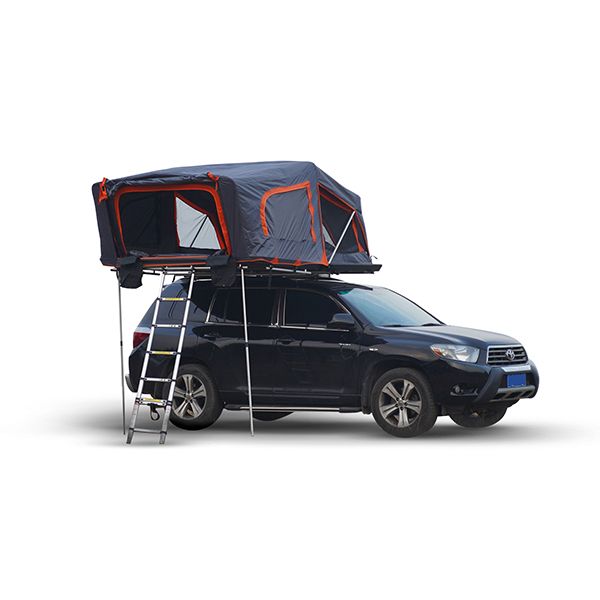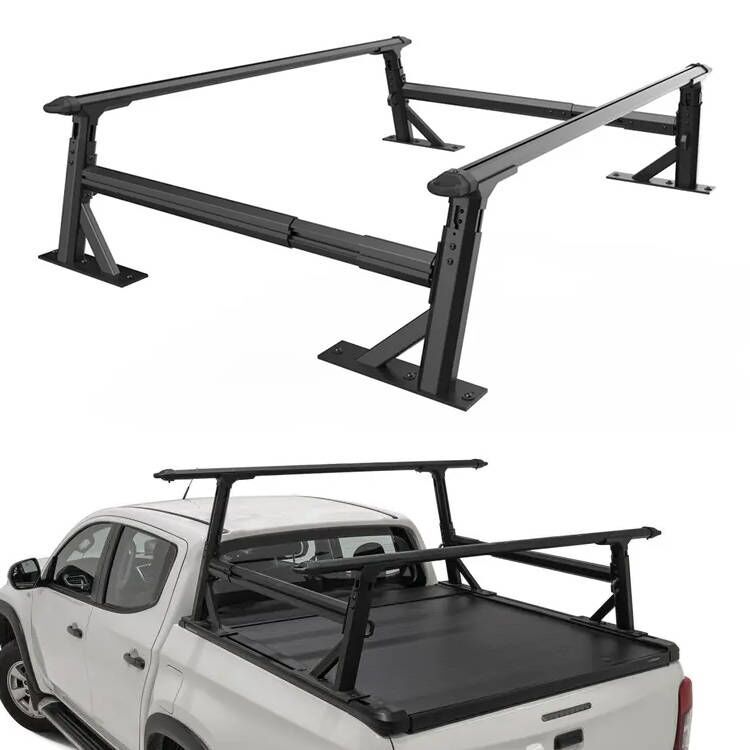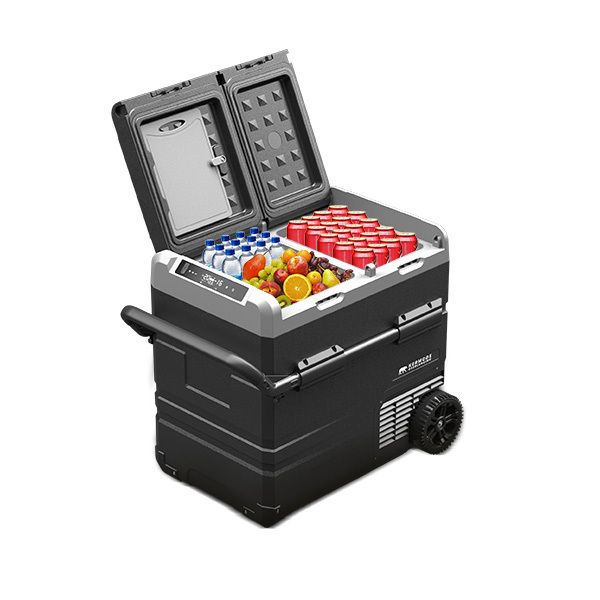Roof Top Tents
Yes, rooftop tents are designed with these limits in mind. Dynamic load refers to the weight your vehicle can handle while in motion, while static load is the weight your roof can support when stationary. Check your vehicle’s roof rack and manufacturer specifications to ensure compatibility.
It is highly unlikely for a rooftop tent to be stolen due to the effort, tools, and multiple people required to remove it. Proper installation further reduces the risk of theft.
Yes, you can store flat blankets, but storing bulky pillows depends on the space inside your tent model. Always ensure the bedding does not interfere with closing the tent securely.
Yes, storing the tent dry is essential to avoid mold and mildew. If you must pack it wet, open it as soon as possible to dry it thoroughly.
Yes, they offer weatherproofing and insulation for year-round use. However, for colder conditions, a quality sleeping bag and additional blankets are recommended for comfort.
The SkyRover Compact Roof Top Tent is ideal for smaller cars and sedans. Lightweight at 34kg (75lbs), it comfortably fits 1-2 people and works well with vehicles with lower roof load capacities.
The Sky Luxe Roof Top Tent is perfect for families or groups, offering spacious sleeping accommodations for 3-5 people with premium comfort features like a high-density foam mattress and optional annex room.
Yes, we provide professional rooftop tent installation services to ensure a secure and proper setup.
Most of our tents are compatible with vehicles equipped with a roof rack and sufficient load capacity. Models like the Sky Luxe and Aluminum Hardshell Tent require racks rated for at least 165 lbs (75kgf).
- Clean the fabric with mild soap and water or a vinegar-water mix to remove dirt and stains.
- Ensure the tent is completely dry before storing to prevent mold.
- Inspect for damage or wear regularly and address issues promptly.
The 7-Foot Inflatable Hardshell Tent features a gas-strut design, allowing quick deployment in seconds—perfect for spontaneous adventures.
Most of our rooftop tents are designed for extreme weather, for instance, the Skyward Inflatable Roof Top Tent is tested to endure level 7 gale winds (15m/s) and features weather-resistant fabrics, making it ideal for coastal or high-wind conditions.
Our Inflatable Roof Top Tent includes skylight windows, offering panoramic views of the night sky, perfect for stargazing enthusiasts.
All our rooftop tents include heavy-duty travel covers and mounting systems that ensure stability during travel. Always double-check the clamps and straps before driving.
The Sky Luxe Roof Top Tent offers luxury features like fire-retardant materials, UV50+ protection, LED lighting, and a premium mattress for unparalleled comfort and convenience.
Vehicle Racks
All our racks are designed for universal compatibility or specific models. For example, the TacomaTrail Elite Roof Rack Fits 2015-2023 Toyota Tacoma models seamlessly, while the Gladiator Bed Rack is tailor-made for Jeep Gladiators. For other vehicles, the adjustable Flexi Rack or Versa Rack offers versatile fits for a wide range of truck models. Always check your vehicle’s dimensions against the rack specifications provided.
Our racks are built for varying needs:
- Flexi Rack: Handles substantial loads with its heavy-duty 3mm galvanized steel construction.
- Endura Rack: Supports 661 lbs static and 441 lbs dynamic loads.
- Universal Truck Cross Bars: Up to 220 lbs dynamic load capacity.
- Overland Pod Truck Rack: 550 lbs static and 331 lbs dynamic loads.
Always consider your load requirements and vehicle’s weight limitations before mounting.
For safety, we recommend staying under 90 mph (150 km/h) with gear mounted to your rack, especially with rooftop tents or heavy cargo. Speed limits may vary depending on conditions and the specific load, so always prioritize caution.
Many of our racks, like the Expedition Platform Max, feature aerodynamic, low-profile designs that minimize wind noise. Proper installation and spacing of crossbars can also reduce noise. Consider using wind fairings or ensuring all bolts and accessories are securely tightened.
While some older setups may be compatible, our newer models, like the Universal Truck Bed Rack, are designed with updated mounting systems for improved security and fit. Refer to the product manual or contact us for guidance on compatibility.
Yes, many of our racks, like the TacomaTrail Elite Roof Rack, are designed to maintain sunroof functionality. Always check the clearance and avoid overloading the rack near the sunroof area.
Spacing depends on the load. For rooftop tents, ensure the crossbars align with the tent’s mounting points. A typical recommendation is 24-30 inches apart for optimal support. Always consult the product manual for specific instructions.
Yes, spare parts for clamps, bolts, and brackets are available for most of our racks. Contact our support team for assistance in ordering replacements.
Yes, these crossbars are ideal for rooftop tents, with a dynamic load capacity of 220 lbs. Ensure the brackets are securely mounted, and always check the load specifications of your tent.
The Endura Rack is built with 3mm steel reinforced with 1.5mm tubes, offering exceptional durability. Its zinc-plated and powder-coated finish resists corrosion, and its load capacity supports rooftop tents and heavy overlanding gear, making it perfect for rugged conditions.
The Overland Pod Truck Rack requires no drilling for installation, making it easy to set up. It includes all necessary hardware and an intuitive instruction guide. For trucks with bed liners, minor modifications may be needed.
Absolutely. With a durable aluminum construction and integrated T-slot system, the Expedition Platform Max is ideal for securely transporting heavy camping equipment, including tents and storage boxes.
The Universal Truck Bed Rack and Endura Rack are compatible with retractable tonneau covers featuring slide slots. Minor drilling may be needed for other types of covers, but their designs ensure seamless integration.
Vehicle Awning
Our awnings are designed to withstand various weather conditions, including wind. Features such as sturdy aluminum frames and reinforced support poles enhance stability. For optimal performance in windy environments, it’s recommended to securely anchor the awning using the provided guy lines and pegs. Additionally, deploying optional side walls can reduce wind exposure.
Yes, our awnings are crafted from high-quality 420D Oxford fabric, which is both waterproof and UV-resistant. This ensures protection from rain and harmful sun rays, providing a comfortable outdoor experience.
The primary difference lies in their coverage area:
- 7 ft Batwing Awning: Provides approximately 100 sq. ft of coverage, suitable for smaller vehicles or setups where space is limited.
- 8 ft Batwing Awning: Offers a larger coverage area of about 110 sq. ft, ideal for larger vehicles or when more sheltered space is desired.
Both models feature a 270-degree design, ensuring extensive shade and protection.
Installation is straightforward and can typically be completed in a few steps:
- Mounting: Attach the provided brackets to your vehicle’s roof rack or crossbars.
- Securing: Fix the awning to the brackets using the included hardware.
- Deployment: Unzip the awning’s storage bag, unfold it, and extend the support poles.
Detailed instructions are included with each product, and no specialized tools are required.
Our awnings are designed for universal compatibility and can be mounted on a variety of vehicles, including trucks, SUVs, trailers, and vans. They are suitable for most standard roof racks and crossbars. If you have specific concerns about compatibility, please consult our customer support team for personalized assistance.
When retracted, the awning should be securely fastened using the built-in straps and stored in its protective PVC cover. This setup is designed to remain attached to your vehicle during travel, ensuring convenience and readiness for your next adventure.
Regular maintenance includes:
- Cleaning: Gently wash the fabric with mild soap and water; avoid harsh chemicals.
- Drying: Ensure the awning is completely dry before retracting to prevent mold and mildew.
- Inspection: Periodically check for any signs of wear or damage and address them promptly.
Following these steps will help maintain the awning’s durability and appearance.
Bike Racks
Our racks accommodate various bikes, including e-bikes, road bikes, mountain bikes, and hybrids. For unique frames, such as step-through designs, an adapter bar may be needed.
Yes, racks like the Universal Bike Hitch Rack for 4 Bikes provide ample spacing (7 inches between bikes) and padded clamps to prevent scratches. Additional straps can further stabilize the bikes during transport.
Yes, our racks handle tires up to 4 inches wide, perfect for fat bikes or heavy-duty mountain bikes. Check individual rack specifications for exact dimensions.
Most of our racks, such as the Universal Bike Hitch Rack for 2 Bikes, feature tool-free installation and can be set up in under 10 minutes. Detailed instructions are included with each product.
Hitch-mounted racks, like the 2-E-Bike Trailer Hitch Rack, work perfectly with vehicles that have rear spoilers, avoiding interference with the car’s body.
Our racks come with integrated locking systems, securing the bikes to the rack and the rack to the hitch. For added security, consider using a secondary lock for long trips.
Yes, our racks are durable enough to stay mounted, but removing them during long idle periods is recommended to reduce wear and improve fuel efficiency. Foldable designs make storage easy.
Yes, racks like the 2-E-Bike Trailer Hitch Rack feature anti-rattle construction and sturdy materials, ensuring a stable ride on bumpy roads.
Clean your rack with mild soap and water, avoiding abrasive chemicals. Lubricate moving parts periodically and store the rack in a dry place to prevent corrosion.
Consider the type of bike, weight, and tire size. For e-bikes or heavy bikes, the 2-E-Bike Trailer Hitch Rack is ideal. For group rides, the Universal Bike Hitch Rack for 4 Bikes offers ample capacity.
Portable Fridges
Portable fridges, like our Kermode EcoChill 55L, provide precise temperature control and can cool or freeze items without needing ice. This eliminates the mess of melting ice and offers more storage space. They’re powered by your vehicle or a wall outlet, ensuring consistent performance during long trips.
Power consumption depends on the model and settings. For example, the Kermode TrekChill 35L uses a maximum of 3.75A at 12V, making it highly efficient, especially in ECO mode. This makes it compatible with small solar systems or car batteries without overloading.
Yes, all our fridges, including the TrekChill 55L, are solar-ready. They can run on 12-50V solar panels, making them perfect for off-grid adventures. We recommend checking your solar panel’s capacity to match the fridge’s power requirements.
Always unplug the fridge before cleaning. Wipe the interior with a mild soap and water solution, and ensure it’s completely dry before storing. For long-term storage, keep the lid slightly open to prevent odors and mold growth.
Our fridges come equipped with an intelligent battery protection system, like the one in the TrekChill 35L, which offers high, medium, and low settings. This ensures the fridge shuts off before draining your vehicle’s battery completely.
The Kermode EcoChill 55L and TrekChill 55L are ideal for families or extended trips, offering dual-zone functionality to simultaneously cool and freeze, with a combined capacity of over 60 quarts.
Yes, the Drawer Fridge Freezer is perfect for compact setups, like camper vans or small vehicles. Its innovative slide-drawer design saves space while still offering a dual-function cooling and freezing solution.
The TrekChill 35L and 55L feature dual-zone technology, rugged off-road wheels, a telescopic handle, and smart WiFi control. These features make them versatile for both overlanding and casual road trips.
Yes, our fridges are designed for durability and performance. The EcoChill 55L, for instance, can maintain temperatures as low as -20°C (-4°F) even in a 25°C (77°F) environment.
All our fridges are designed with portability in mind. For example, the TrekChill 35L features oversized wheels and a sturdy handle for easy transportation, making it perfect for outdoor adventures.
Dual-zone fridges, like the TrekChill 55L, have two compartments with independent temperature controls. You can use one as a freezer and the other as a fridge, or set both to the same function based on your needs.
We offer a 5-year warranty on the compressor and a 1-year warranty on all other parts. Our dedicated support team ensures quick resolution of any issues.
Yes, the TrekChill models come with smart app WiFi control, allowing you to monitor and adjust temperature settings directly from your phone.
While our fridges are efficient, pre-cooling them before travel helps maintain the temperature for extended periods if the power source is interrupted.
Depending on the model, accessories like detachable doors, interior LED lights, chopping boards, bottle openers, and cupholder doors are included to enhance your experience. For example, the TrekChill 35L features all of these plus a built-in drain plug for easy cleaning.
About Us
We’re based in Nanaimo, on beautiful Vancouver Island, British Columbia. Our showroom is open for you to explore and try out our rooftop tents in person.
Yes, we do! We ship our rooftop tents and other products throughout Canada, including Vancouver, mainland British Columbia, and beyond.
Our specialty is fibreglass hard shell rooftop tents, designed for durability, comfort, and ease of use. We also offer a range of overlanding essentials, including awnings, bed racks, crossbars, and more, to enhance your adventures.
Our rooftop tents are lightweight, durable, and feature aerodynamic designs. They’re easy to install, built with safety in mind, and designed to make camping as comfortable and convenient as possible.
It’s very simple. Most of our rooftop tents can be set up in minutes. If you purchase a tent at our showroom, we’ll even help you install it for free to ensure you’re ready for your next adventure.
Yes, they are! Our tents are spacious enough to comfortably fit a family of four or three adults. They’re perfect for creating safe and memorable family camping experiences.
A rooftop tent offers more convenience and comfort. There’s no need for a designated campsite, it sets up quickly, provides better protection from the elements, and eliminates the hassle of sleeping on uneven ground.
Absolutely. Our tents are perfect for digital nomads who want to explore while staying connected. They’re durable, easy to set up, and allow you to work or relax in some of the most beautiful locations across Canada.
Our tents work with most vehicles that have a roof rack and the necessary weight capacity. If you’re unsure, we’re happy to help you find the right setup for your vehicle.
Every purchase comes with everything you need to get started, including mounting brackets, tools, and a telescoping ladder.
Yes, we do! We’re always here to answer your questions, help with installation, or provide advice on using and maintaining your gear. We’re committed to making sure you have the best possible experience.






